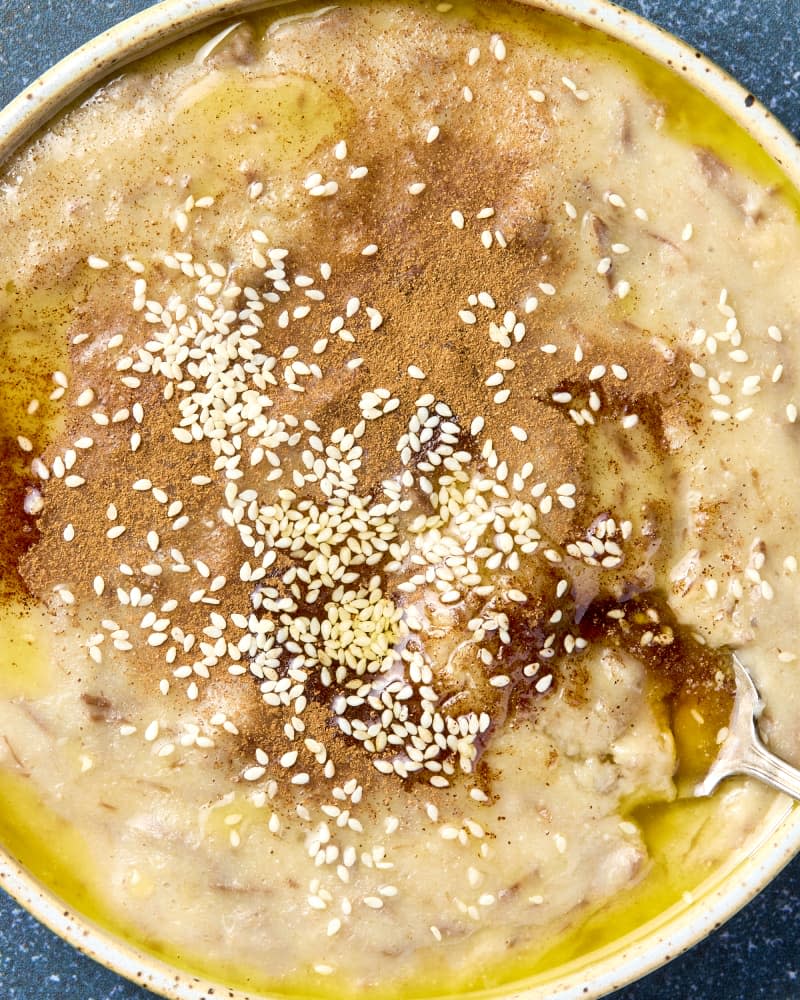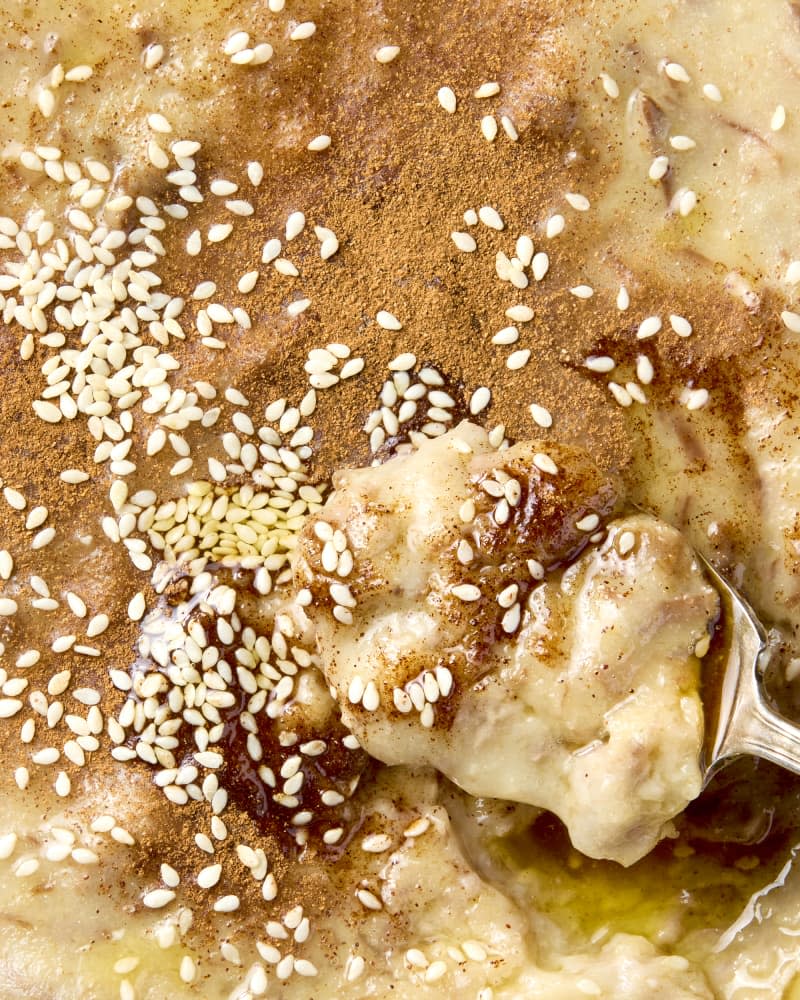This Iranian Breakfast Is the Coziest Thing You’ll Make This Month

Haleem is a rich and hearty porridge-like dish that’s popular in many different variations in Western, Central and Southern Asia. In Iran, haleem varies widely, with regional differences reflecting local tastes and ingredients, but it’s typically made with a combination of wheat, meat (often lamb or turkey), sometimes chickpeas, and varying spices. Traditionally served for breakfast, haleem is a wholesome and stick-to-your-ribs kind of meal at any time of day.
While haleem can be enjoyed year-round, it’s especially popular during colder months when street vendors and dedicated haleem shops serve it as a comforting breakfast choice. Nowadays, it’s a beloved weekend staple for families and friends to enjoy together, gathered around the breakfast table. I have fond but distant memories of enjoying Haleem as a child visiting the Caspian Sea. Now, cooking it for my family, it leads to lengthy conversations and transports me back to those moments, flooding my senses with its familiar taste. It serves as a reminder of how familiar flavors and textures have an incredible ability to evoke nostalgic memories.
Why You’ll Love It
Haleem is extra comforting. The key to preparing haleem is the prolonged cooking process, allowing the flavors to meld together, resulting in a comforting and creamy consistency.
It’s historically prized for its nourishing qualities, providing energy for long journeys and demanding work. When you eat haleem, you’re sure to be satisfied.

Key Ingredients in Haleem
Wheat: Traditionally, haleem was prepared with whole wheat grains, involving a lengthy overnight cooking process that required attention. Nowadays, home cooks use pelted (pearled) wheat to expedite the process, which is what I call for here.
Lamb: Lamb neck or shoulder pieces are the classic meat selection. As they cook to a fork-tender texture, they can be effortlessly shredded and mixed into the porridge.
How to Make Haleem
Like other hearty Iranian stews, traditional haleem preparation is a true labor of love, requiring patience and dedication to the rituals and traditions.
Soak and cook the wheat. Soak the wheat in plenty of water overnight to hydrate the grains thoroughly. Dain and transfer it to a pot with more water and salt, and simmer until fully softened. Then purée in a blender until the mixture resembles a creamy wheat porridge.
Cook the lamb. Using onion and a cinnamon stick for aromatics, simmer the meat in water until it’s fork-tender. Remove the lamb pieces and shred it.
Bring it all together. Combine the shredded meat with the creamed wheat and continue cooking until the mixture thickens further to meld the flavors and get a nice velvety texture.
What to Serve With Haleem
Iranians sprinkle sesame seeds, cinnamon, and a little sugar on haleem to enhance its flavor complexity. Alternatively, you can omit the cinnamon and sugar, add a touch of salt, and serve haleem as a hearty, savory porridge.
Haleem Recipe
Trust the long cooking process. It’s key for the most comforting and delicious consistency.
Prep time 5 minutes
Cook time 2 hours
Makes Makes about 7 cups
Serves 6
Ingredients
1 cup pelted wheat
4 cups water, plus more for soaking the wheat and making the lamb broth
1 1/2 teaspoons kosher salt, divided, plus more as needed
1 medium yellow onion
1 1/2 pounds bone-in lamb shoulder chops (about 1-inch thick) or lamb neck bones
1 (3-inch) cinnamon stick
10 tablespoons unsalted butter, divided
2 tablespoons white sesame seeds
1 tablespoon ground cinnamon
Granulated sugar, for sprinkling
Instructions
Place 1 cup pelted wheat in a large bowl and add enough cool water to cover the wheat by about 2 inches. Cover and let soak overnight at room temperature.
Drain the wheat and transfer it to a medium saucepan. Add 4 cups water and 1/2 teaspoon of the kosher salt. Bring to a simmer over medium-high heat. Reduce the heat to low. Cover and cook, stirring every 30 minutes or so, until the wheat is completely softened, about 90 minutes. Meanwhile, make the lamb broth.
Peel and quarter 1 medium yellow onion. Place the onion, 1 1/2 pounds bone-in lamb shoulder chops or lamb neck bones, 1 (3-inch) cinnamon stick, and the remaining 1 teaspoon kosher salt in a large saucepan or small Dutch oven. Add enough cool water to cover the mixture by about 2 inches (about 12 cups). Bring to a simmer over medium-high heat. Reduce the heat to low, cover, and cook until the meat is tender and easily falls off the bone, about 90 minutes.
Gently transfer the lamb pieces to a clean cutting board. Pour the broth through a fine-mesh strainer set over a heatproof bowl. Discard the onion and cinnamon but reserve the pot.
When the wheat is ready, add 1 1/2 cups of the broth and stir to combine. Transfer to a blender and blend until smooth (blend in batches if needed). (Alternatively, blend directly in the saucepan with an immersion blender until smooth.) Transfer to the reserved pot, add 4 tablespoons of the unsalted butter, and stir until melted.
When the lamb is cool enough to handle, remove and discard the bones. Shred the meat into thin pieces with 2 forks or your fingers. Add the lamb to the wheat purée and stir until combined.
Cover and simmer over low heat, stirring frequently so that a crust doesn’t form on the bottom of the pan, for about 30 minutes to let the flavors meld. If the mixture becomes too dense or dry, add more of the reserved broth as needed. Taste and season with more kosher salt as needed.
Just before the haleem is ready, melt the remaining 6 tablespoons unsalted butter in a small saucepan over low heat. Divide the haleem into individual serving bowls. Drizzle melted butter over each portion, and sprinkle with 2 tablespoons white sesame seeds, 1 tablespoon ground cinnamon, and granulated sugar as desired.
Recipe Notes
Storage: Haleem can be refrigerated in an airtight container for up to 3 days. Add more water or leftover broth when reheating to loosen, as the haleem will thicken up more. Do not freeze.

